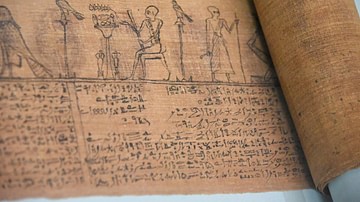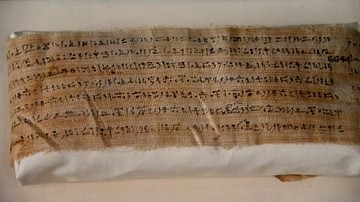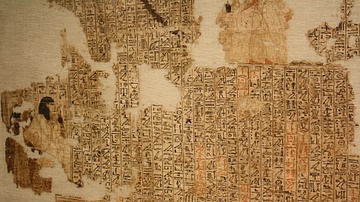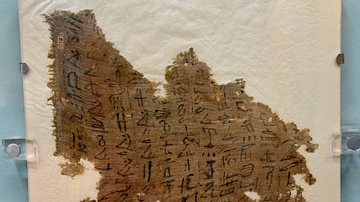Search
Search Results

Image
Book of the Dead, Ptolemaic Period
A detail from the Book of the Dead of Tayesnakht from Thebes, Ptolemaic Period, 332-30 BCE. (Egyptian Museum, Turin)

Image
Geb & Nut, Book of the Dead
A detail of the Book of the Dead of Henuttawy, depicting the goddess Nut arched over the god Geb. Geb is depicted with the head of a snake. The full papyrus measures 74 cm x 23 cm (29 in x 9 in). Egypt. Third Intermediate Period (c. 1069-525...

Image
Hieratic Book of the Dead of Padimin
Hieratic Book of the Dead of Padimin written on linen; mummy wrapping. From Akhmim, Egypt. Late Period, after 664 BCE. (The British Museum, London)

Image
Pharaoh, Book of the Dead
A detail from the Book of the Dead of Tayesnakht from Thebes, Ptolemaic Period, 332-30 BCE. Pharaohs often wore two crowns to signify the unification of Lower and Upper Egypt. (Egyptian Museum, Turin)

Image
Mummy Linen Inscribed with Portion of the Book of the Dead
Mummy wrapping of a man named Djedher, son of Sekhmetnefret, inscribed in hieratic with funerary texts from the Egyptian Book of the Dead. From Saqqara, Egypt, Late Period of ancient Egypt, 4th century BCE or later. The British Museum, London...

Image
Weighing the Heart, Book of the Dead
Weighing of the heart scene, with Ammit, the 'Devourer of the Damned' sitting, from the Egyptian Book of the Dead of Hunefer, Egypt, 19th Dynasty.
The British Museum, London.

Image
Egyptian Book of the Dead, Pashed Script
A portion of an Egyptian Book of the Dead in the hieroglyphic cursive script of Pashed. Papyrus. XVIII-XIX Dynasty. (Archaeological Museum, Milan, Italy)

Image
Egyptian Book of the Dead Fragment
Fragment of a linen mummy shroud with texts from the Book of the Dead, written in ink. From Thebes, Egypt. 18th Dynasty, circa 1500 BCE.

Image
Priest, Book of the Dead
A detail from the Book of the Dead of Aaneru from Thebes, Third Intermediate Period, 21st Dynasty, 1070-946 BCE. (Egyptian Museum, Turin)

Video
The Egyptian Book of the Dead - A Guide to the Underworld
The Egyptian Book of the Dead, or better translated The Book of the Coming Forth by Day or Spells for Going Forth by Day is a collection of spells that help a deceased soul navigate the afterlife and make it to the Field of Reeds, or paradise...